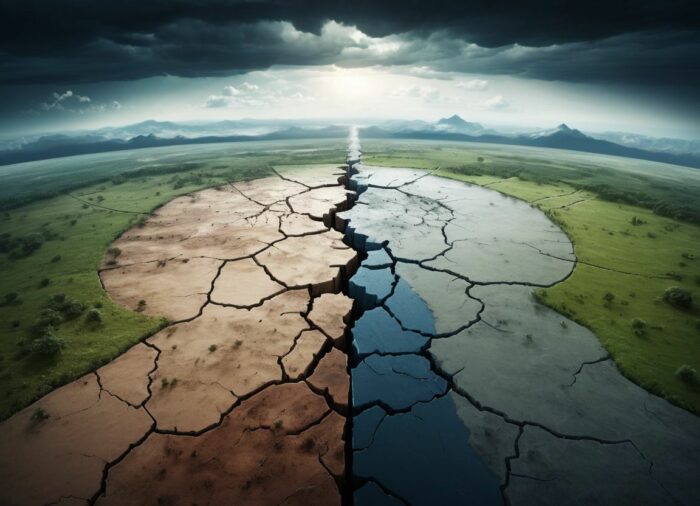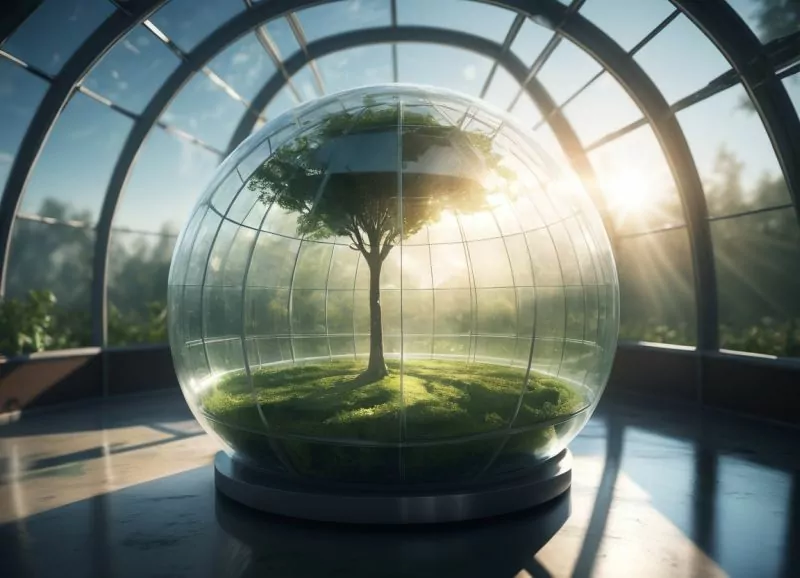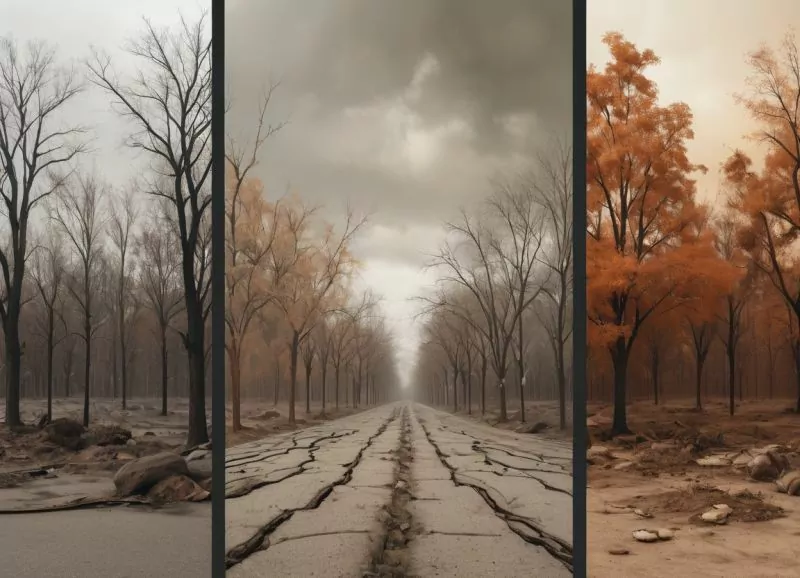
- 1 Introduction. Something’s not right with the weather, is it?
- 2 Where it all began: what actually caused global warming
- 3 What’s already happening: The consequences we see every day
- 4 Forecasts: What will the climate be like in 10, 20, 50 years?
- 5 And now — about hope: what can be done and who’s already doing it
Introduction. Something’s not right with the weather, is it?
Let’s be honest—doesn’t it feel like something’s off? Global warming? One day it’s May and you’re walking around in a T-shirt, and the next day hail’s pelting down like it’s mid-winter. And this isn’t just some exaggerated panic. It’s reality, and we can’t really ignore it anymore. The weather’s gone weird. Snow in April, heat in September, crazy storms in the middle of what should be a calm summer—when all we wanted was a gentle breeze and some sun, not a natural disaster.
All of this is part of a process that honestly sounds like the plot of a sci-fi movie: global warming. But unfortunately, it’s not fiction. It’s already happening, and it’s happening now. And the big question is—what’s next?
Because climate change isn’t just about glaciers melting somewhere far off in Antarctica. It’s about flooded streets in Lviv, dry cracked soil near Kropyvnytskyi, suffocating heat in cities where the asphalt practically melts beneath your feet. And yeah, about people who are genuinely confused about why every year feels so different now.
Alright, let’s not get too dramatic… although, it’s a bit scary. Let’s try to figure it out—how we got here, what’s going on with the climate, where these greenhouse gases are coming from, what the forecast looks like for the coming decades—and most importantly, is there anything we can still do about it?
Where it all began: what actually caused global warming

It’s not easy to admit, but we humans played a big part in this whole mess. Sure, Earth has gone through warm and cold cycles for millions of years, way before the first tractor rolled across a field or the first greenhouse was built. But what’s happening now—it’s just way too fast. Nature doesn’t shift like this on its own. At least, not like this.
One of the biggest culprits? Greenhouse gases. Yeah, not just some boring term from a science textbook—these are actual molecules floating around in the air, trapping heat in the atmosphere like a giant invisible blanket. They keep the heat from escaping into space. And so the planet gets warmer.
The main characters in this story:
- Carbon dioxide (CO₂) – good old CO2 from cars, factories, power plants. It’s the most common one.
- Methane (CH₄) – surprisingly, yeah: big herds of cows, swamps, landfills—they all release methane. And it’s way more effective at heating the planet than CO2.
- Nitrous oxide (N₂O) – this comes from fertilizers. So agriculture has its own carbon footprint too.
Just picture Earth tucked under a thermal blanket. Each year, that blanket gets thicker. All thanks to how we live. We burn coal, oil, gas. Cut down forests that used to absorb CO2. We build megacities that run on a “more, faster” mindset, forgetting that the planet isn’t a phone charger. It can’t just keep up with our pace forever.
Fun fact
Or maybe not-so-fun: back in 1988, NASA scientists were already warning us about the risks of global warming. But at the time, the world was too busy with the Cold War, perestroika, and Walkmans. So, yeah… here we are.
And here’s the thing: since 1900, the average temperature of the planet has gone up by more than 1°C. Doesn’t sound like much, right? Just one degree? But on a global scale, that’s like… well, imagine your body temperature going from 36.6°C to 38°C. That’s not just “a bit warm,” that’s the beginning of a fever.
Oh, and most people assume that it’s factories causing the most emissions. But surprise: one of the biggest sectors is energy—especially where they’re still burning coal. Yes, even in the 21st century.
What’s already happening: The consequences we see every day
There’s this thing — you hear something on TV and think, “Well, that’s far away. Doesn’t concern me.” And then — bam! — it turns out it’s your street that gets flooded after a storm, and your grandma’s apple harvest just disappears. And suddenly, melting glaciers in Greenland don’t seem so distant anymore.
The truth is, climate change has been among us for a while now. It’s in the air we breathe. In the water we drink. In the food we grow. And in that weird gut feeling that something’s off — even if we can’t quite explain what it is.
Let’s look at how it’s showing up. No charts — just real life.
Okay, winter. We used to look forward to it. Now? Snow shows up in December, but only for a week. Then it rains. Then it freezes. And… nothing. When was the last time we had a proper, steady winter in Ukraine? And remember that summer of 2010, when temperatures hit 40°C? People joked that you could fry eggs right on the hood of your car in Kyiv. Funny… but not really.
Yeah, summer’s become… unbearable. Especially in the big cities. Asphalt melts, trees can’t cool the air fast enough, and air conditioners? They’re not a luxury anymore — they’re survival gear. And it’s not just people. Animals suffer too. Bees, for example, are disappearing. Gone. And without them — well, no honey. And more importantly, no apples or watermelons either. Because no one’s there to pollinate them.
The rain
And what’s up with the rain? It’s a total lottery. One day, drought so intense that fields crack like deserts. The next — a downpour that floods basements. In Chernivtsi a few years back, people had to evacuate their homes. Because of a flash flood. That kind of thing? It’s not rare anymore.
Speaking of water — it’s becoming a scarce resource. Not just in Africa. In Ukrainian villages, wells are drying up. No joke. And rivers are shrinking — the Danube, the Dniester, even the Dnipro. That hits everything: fishing, ecosystems, hydro plants.
Another side of it? Natural disasters. There are more of them. And they’re nastier. Hurricanes, tornadoes, dust storms. Yep — in Ukraine! Not just in Texas. Remember that freak storm in Kyiv region back in 2023? Trees snapped like twigs. Roofs flew off homes. People said, “Never seen anything like it.” And it seems… we’re going to see more of it.
And farming? Farmers are basically losing their minds every year. How do you plan your crops when March doesn’t feel like March anymore, and June is more like August? Yields are falling. So are profits. Prices? Skyrocketing. You feel it in the store, even if you’re not thinking about it.
And health — that’s a whole separate mess. Heatwaves strain your heart. Allergies are getting worse because pollen hangs around longer. Infections? Malaria’s already been spotted in Europe. In Italy. And ticks? There are so many now in the Carpathians that you basically need bug spray just to step outside.
And then there’s something you can’t measure with numbers, but you can see it in people’s eyes: anxiety. People feel like the world is becoming less predictable. That eats at you. Especially the younger generation. Because imagining yourself in 2050? That’s not a sci-fi dream anymore. It’s a real fear.
Some things you might not expect, but they’re true:
- Palm trees are growing in Crimea and Kherson — just like in Sochi.
- Snow is disappearing from the Carpathians — and ski resorts are barely surviving.
- Kyiv is now on the list of major cities most vulnerable to climate change. Surprise, right?
But here’s the main thing: we can’t undo these changes. All we can do now is try to stop them from getting worse — or at least slow them down. And that’s exactly what we’ll talk about next — the future. The scenarios scientists are laying out. Some are hopeful. Some — not so much.
Forecasts: What will the climate be like in 10, 20, 50 years?

Imagining the future is always a bit scary. Especially when it’s not about flying cars, but about water shortages. About summers where stepping outside without a hat feels like sticking your head in a microwave. And winters… that aren’t really winters anymore — just a long, grey, damp in-between season.
But let’s give it a try. Because these forecasts aren’t some kind of palm reading. They’re the result of thousands of simulations, models, graphs — and, ultimately, human intuition. And despite the different scenarios, the overall picture? Like a thriller: the further you go, the more intense it gets.
2030: Last chance or too late already?
The year 2030 — it’s right around the corner. And it’s critical. According to the IPCC (Intergovernmental Panel on Climate Change), we only have a few years left to cut greenhouse gas emissions almost in half. Otherwise — brace yourself.
What happens if we do nothing? Global temperatures might rise by another +1.5°C. And again — sounds small, right? But no, on a planetary level that’s like a person’s temperature jumping from 37 to 39. Not just a slight fever — we’re talking real trouble.
More heatwaves. In big cities like Kyiv or Dnipro, summer temps could easily hit +45°C. Especially if it’s all concrete, asphalt, and barely any trees. Power grids? They’ll “melt” — literally. And air conditioners? Not comfort anymore — survival tool.
2050: Earth, but not quite home anymore
The year 2050 feels distant, but it’s when today’s kids will be adults. And guess what? Half of the world’s current cities might become unlivable — too hot, too dry, or underwater.
In Ukraine? Not great. Parts of Odesa region might lose entire villages to flooding. Some areas will dry out like semi-deserts. Central Ukraine will face extreme water shortages. Crimea? It’ll feel like Central Asia.
Farming? It’ll change completely. Our usual crops — wheat, corn — might not grow here anymore. We’ll have to switch to lentils, sorghum, or — weirdly — rice.
Infrastructure? Soviet-era buildings won’t survive the new climate. Sea levels could rise about 0.5 meters. Sounds small, but imagine the sea flooding ground floors in Zatoka. Not science fiction — just science.
2100: Planet 2.0 or a wreck?
Looking ahead to 2100, we’re deep in guesswork — but based on real trends. There are a few scenarios.
- Optimistic — humanity gets its act together, emissions drop, green thinking wins. Warming caps at +1.5 to 2°C. The world changes but adapts. Not paradise, but manageable.
- Realistic — we make changes, but too slowly. Warming hits +3°C. Millions of climate refugees, new pandemics, fights over resources. Harsh, but not apocalyptic.
- Pessimistic — nothing changes. Warming hits +4 to 5°C. That’s a disaster. The planet turns chaotic. Asia and Africa dry out. Europe drowns in refugees and storms. Ukraine? A survival zone.
What do the models say? A simple (Scary) table:
| Year | Temp ↑ (°C) | Sea Level ↑ (m) | Consequences |
|---|---|---|---|
| 2030 | +1.5 | +0.1 | Heatwaves, floods, energy blackouts |
| 2050 | +2.5 | +0.3 | Crop failures, water scarcity |
| 2100 | +4.0 (or +1.8) | +0.5–1.0 | Mass migration, uninhabitable regions |
All this sounds… well, not great. But there’s a light ahead. A real one. Because up next — we talk about hope.
And now — about hope: what can be done and who’s already doing it
Okay, let’s admit it — the prospects don’t look too bright. But here’s the paradox: humans are best at taking action only when things get really bad. Not earlier. And right now is that moment when things are already “bad enough,” which means — something will start changing.
And honestly, it already is.
Tech that actually works
You can laugh at “eco-activists” online all you want, but while we’re eating borscht with a plastic spoon, someone somewhere is actually changing the game. In Norway, 8 out of 10 new cars are electric. In Germany, coal plants are gradually shutting down. China — yes, China — they’ve built the largest solar farms on Earth.
In Iceland, there’s already a facility that literally sucks CO₂ out of the air and injects it into the ground. This isn’t sci-fi — it’s a real startup called Climeworks, operating for several years already. And they’re not the only ones.
There’s more: solar panels that work even in cloudy weather, and coatings for buildings that reflect heat and keep rooms cool without AC. It’s all real. Just… not here yet.
And what about us? Is anything happening in Ukraine?
Oh yes. Not as fast as we’d like, but not zero either.
In Ukraine, we’re seeing the first “green offices” designed to consume minimal energy. Some residential complexes in Kyiv already have their own solar panels. In Lviv, there’s a waste sorting station that actually works. And that’s just the beginning.
Some farmers in Odesa, Mykolaiv, and even Cherkasy regions are testing drought-resistant crops. Because the climate is changing — so farming has to change too.
And believe it or not, Ukrainian scientists are developing their own climate adaptation programs. It’s not just theory — it’s real models: when to plant, what to grow, how to retain soil moisture. Sounds mundane? Maybe. But it’s the kind of thing that might save our dinner table in 2035.
What can people do? Like, just regular people?
There’s this idea that one person can’t make a difference. But actually, every big change starts with “just one person.” For example:
- Ditching unnecessary plastic. Choosing not to buy 20 plastic bags at the store — sounds small? It’s not. It counts.
- Transport choices. Walking, biking, trolleybus — it’s not just about saving money. It’s less CO₂.
- Making homes energy-efficient. Someone insulates their house — saves on heating and cuts emissions. A win-win.
And then — there’s your voice. Supporting leaders who advocate for green energy, smart adaptation plans, and climate education. Because that, too, shapes the future. Not somewhere far away — right here.
Examples that give hope
Here’s a handful of real-life examples that actually inspire:
- Costa Rica — over 99% of electricity from renewables. No nuclear, no coal. Just rivers, sun, and wind.
- The Netherlands — not just tulips and bike lanes, but a world-class system protecting against rising seas. They’ve basically outsmarted the ocean.
- India — built the largest solar power plant in the world on abandoned land. And this in a country where poverty is still everywhere.
- Greta Thunberg — whatever your opinion, one schoolgirl made the entire world talk about climate. She just showed up with a sign.
The other side of hope — adaptation
Even if we don’t stop the whole thing, there’s another path: adapting. How? Like this:
- Architecture that cools itself.
- Cities with more green, more water, more shade — “urban jungles” in a good way.
- Farming that doesn’t drain the soil but preserves moisture.
- Schools that teach kids how to live in a changing world, not just memorize facts.
This isn’t fiction. In Japan, they’re already building schools with rooftop gardens where kids grow vegetables. Germany, students learn how to stay safe during heatwaves. In France, cities get “green passports” — step-by-step climate-resilient transformation plans.
So here’s the thing:
We still have a choice. We can ignore, we can panic — or we can act. Step by step, with the understanding that this isn’t just about “the environment” or “weather.” This is about home. And we’re not renters here. We’re the owners.
Read more: